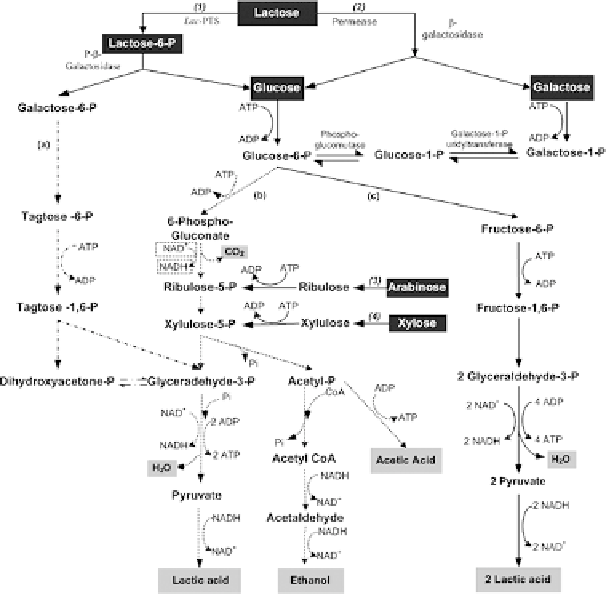Environmental Engineering Reference
In-Depth Information
Fig. 2
Metabolic pathways of lactic acid bacteria
degradation of its two moieties, glucose and galactose. Normally, these LAB strains,
including
Lactobacilli,
contain one or both of two systems for the transport of lac-
tose and galactose into the cell: phosphoenolpyruvate-lactose phosphotransferase
system (
Lac
-PTS) (Fig. 2, route 1) and lactose permease system (Fig. 2, route 2).
When the
Lac
-PTS system is applied, lactose is translocated through the cell mem-
brane to yield phosphorylation of the lactose molecule in the 6th position of the
galactose moiety. The lactose phosphate is cleaved by phospho-D-galactosidase
to yield glucose and galactose 6-phosphate. Glucose is further metabolized as
described previously through the EMP or PK pathway, whereas galactose 6-
phosphate is metabolized through the D-tagatose 6-phosphate pathway to form
dihydroxyacetone phosphate and glyceraldehyde-3-phosphate, which are further
metabolized by the enzymes of the glycolytic pathway (Fig. 2, route a). In the case of
entry via a permease system, lactose is not modified, but broken down directly into
glucose and galactose. Then glucose is converted to two moles lactic acid through
the homofermentive pathway or to mixed lactic acid and acetic acid or ethanol
through the heterofermentive pathway. Galactose is metabolized via the Leloir path-
way. That is, first, galactose is phosphorylated from ATP at the C-1 position by
galactokinase (Fig. 2). Galactose-1-phosphate is then converted into UDP-galactose

Search WWH ::

Custom Search